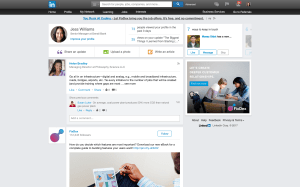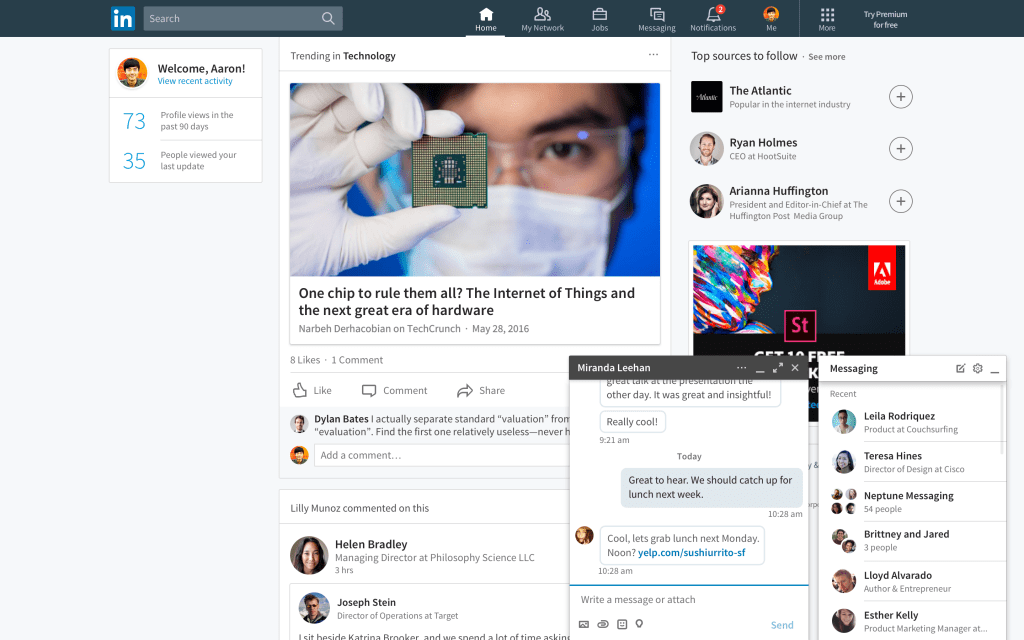After a short preview in September last year, and the small matter of getting acquired for $26.2 billion by Microsoft, today LinkedIn — the social network for the professional world with close to 470 million users — is finally unveiling its redesign of its desktop site, complete with a simpler, app-like look; a new messaging experience that appears as a pop-up on the homepage; and updated search features. LinkedIn said the new desktop version will be rolling out globally over the next few weeks.
LinkedIn’s director of engineering, Chris Pruett, describes the update — which has overhauled both the front end and back end — as the biggest it has had since the launch of LinkedIn itself. It comes about a year after LinkedIn unveiled a revamped set of mobile apps, and the idea is to give the new desktop version more parity with that both in terms of look and functionality.
 The new app is moving away from the busy pages of the past (see the old feed here to the right) and attempting to reduce clutter by reducing the navigation to seven areas: Home (Your Feed), Messaging, Jobs, Notifications, Me (your old profile page), My Network, and Search. There are also more, easier to find links to newer projects at LinkedIn that it also hopes to push more in the future, such as LinkedIn Learning, which it launched at the same time as it previewed this desktop refresh in September.
The new app is moving away from the busy pages of the past (see the old feed here to the right) and attempting to reduce clutter by reducing the navigation to seven areas: Home (Your Feed), Messaging, Jobs, Notifications, Me (your old profile page), My Network, and Search. There are also more, easier to find links to newer projects at LinkedIn that it also hopes to push more in the future, such as LinkedIn Learning, which it launched at the same time as it previewed this desktop refresh in September.
Two of the most notable changes in this new version are how LinkedIn is approaching private messaging, and also how it’s moving to make its public messaging — its feeds — better and more used.
Private messaging has always been a big part of how people connect and communicate on LinkedIn, and here it looks like the company is making some big changes to grow that channel even more. You can now chat on your home screen through a pop-up window, rather than going to a separate place that moves you away from your main page (this it seems is also designed to keep more audience on that feed).
And now, LinkedIn is introducing its own form of ‘chatbots’. To be clear, I’m referring to these as chatbots, but LinkedIn is not — it doesn’t follow you and steer the whole conversation, but it’s a little helper that will suggest things to talk about to “break the ice” with people. It will also suggest people you can chat with at companies if you aren’t even at the ice-breaking point.
The feed itself is going to be filled with significantly more algorithms to suggest content to you — both organic and sponsored, “native” content — a new ad unit that LinkedIn is hoping to expand. Among the organic content, you’ll be seeing more suggestions of people to follow, as well as more content from influencers alongside news curated by LinkedIn itself and its editorial team.
As we’ve described before, LinkedIn’s approach to news in this new version appears to be aimed at getting more people to visit and stay on its site for longer, for more than just updates on its professional network, but a place where you might go to look for news that’s relevant to your work life, and to life. This will now include breaking news alerts and a whole set of actions that will come alongside them: supplemental links to learn more; people on LinkedIn who are connected to you and relevant to the story; and links to relevant Influencer posts.
All this seems to be a direct descendant of the news aggregation services that LinkedIn picked up by way of its 2013 acquisition of Pulse. Since then, LinkedIn has been making a lot of updates and integrations between Pulse and the bigger network, but to be honest I’ve never been too sure about just how much traffic comes and reads the LinkedIn news feed. That’s something that LinkedIn wants to change, of course, as looks to bring in more revenue through advertising (more on that below).
On top of this, there will now be new search features, focused on a universal search box that lets you search by people, jobs, companies, groups and schools.
But with the redesign also come some changes that may not make everyone happy.
In December last year, to the dismay of some users, LinkedIn quietly axed a number of features that were given to the Premium (paid) subscription tier, including a number of search parameters (among them: years of experience, function, seniority level, and when a user joined) and the ability to search in Groups.
There is a chance that LinkedIn may offer these again in a new search product, but for now, if you want these features, you have to opt for the more expensive ($64.99 versus $47.99 per month) Sales Navigator tier.
“The big picture, the way we approached the redesign, is that we wanted to create a more focused experience,” Amy Parnell, the senior director of user experience design at LinkedIn who has been overseeing the new version, told me in an interview.
“There were a number of features where we didn’t see large engagement, and we wanted to clean up the experience and make it more focused, so we had to make some calls about where to invest and expand. It doesn’t make sense to continue to invest in those search features, in terms of the Premium tier.” She added that there are other “insights” that Premium users will be getting in other areas like jobs and growth trends (which is not actually the same thing for those who were using these features before).
This fits in with longer-term changes at the company, which has gradually been tightening features and services that it provides to users on different tiers of its service as well as developers.
Regular, non-recruitment industry users, for example, used to be able to look at people’s full profiles without logging into a LinkedIn account of their own, jumping straight to them from, say, a Google search. Now, you have to be logged in to see full profiles (you can still go incognito in your settings if you want to stay anonymous to the person, if not LinkedIn itself). Some have come up with workarounds for how to surmount some of these limits.
LinkedIn may argue that it’s doing this in the name of making the site easier to use by focusing on more popular features, but it’s undeniable that it’s also tweaking things in the name of more monetization.
That monetization strategy follows also from an update that came out yesterday: LinkedIn is now working with DataSift to parse its public data.
The data, in turn, becomes part of a larger DataSift product for brands and marketers that they use to monitor social networks, to consider how and if they will use them in ad campaigns. LinkedIn is trying to boost its advertising revenues, and third-party access of this kind is essential to advancing that.






































Comment